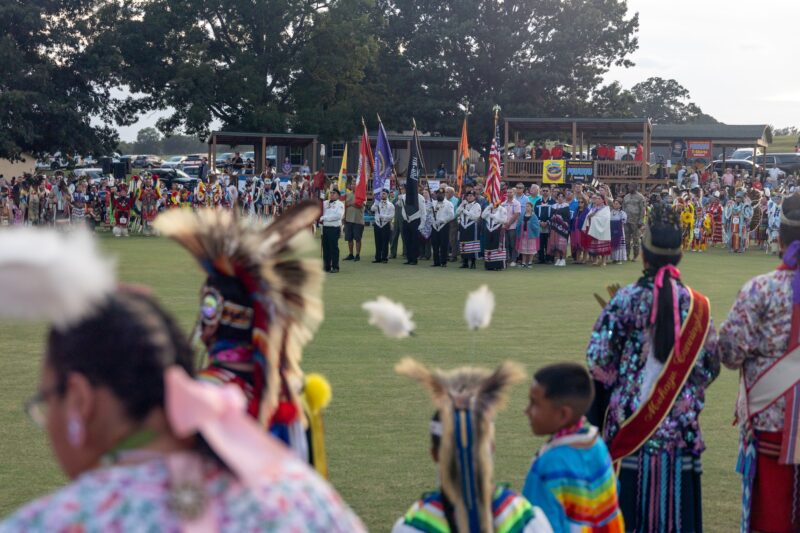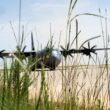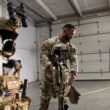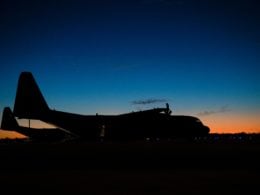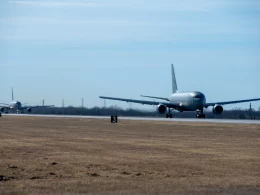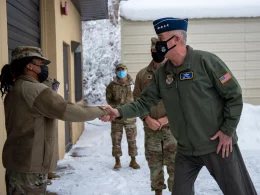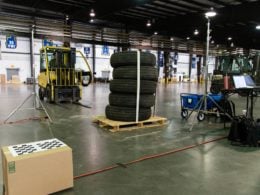TAHLEQUAH, Okla. —
In an address to the Cherokee Nation during their annual Cherokee Days event Aug. 30, Gen. Mike Minihan, Air Mobility Command commander, had a simple message.
“Native Americans serve in the military at a higher rate, on average, than any other American demographic,” Minihan said. “We thank you for your legacy of service, our nation is better off for it, and we invite your children and grandchildren to join our ranks, gain necessary skills that the military offers, and bring those skills home to enrich their families and communities.”
The visit allowed Minihan, members of Air Force Recruiting Service and the nearby Air Force Sustainment Center at Tinker AFB, Okla., to thank the Cherokee Nation for the military and civil service of its members as well as understand barriers to service for future generation of potential recruits.
Today, just 23 percent of American youth are qualified to serve without a waiver, and only 10 percent say they are even interested in military service, often because, unlike earlier generations, most Americans do not actually know anyone who has served in the military.
Minihan hoped to change that, at least for the approximately 160,000 expected visitors to the Cherokee Days events, a homecoming of sorts held annually at the beginning of September.
As part of this visit, Minihan and other Air Force leaders attended a luncheon with Cherokee Nation veterans, toured an innovative veteran’s housing project which trains young military personnel on vertical and horizontal construction techniques while the end product houses veterans in need of assistance, and participated in the entrance to the grand powwow.
Throughout the day, he shook hands, posed for pictures, and held engagements with tribal leadership, proclaiming the benefits—and inclusivity—which exists through military service.
“We’ve been on a journey across the past two years, and I am grateful for occasions where we can bond together with cultures and move all of us forward-together,” said Minihan. “We do this by removing barriers and to help make it easier for these cultures to service their nation if they so wish.”
The Air Force is hard at work identifying barriers to service and, when possible, eliminating them. To this effort, they established a barrier analysis working group, the Indigenous Nations Equality Team, to advise senior Air Force leaders of practical ways in which military service can be more in reach for people while maintaining military readiness.
INET, led by Tuskegee native Brig. Gen. Terence Adams, fights for these updates and has partnered with AMC to assist with the Warriors Recruiting Warriors events. Their members, Airmen from tribal and Native communities, help to bridge the gap between the culture of the Air Force and indigenous cultures.
One example of their efforts was a recent update to Air Force Instruction 36-2903, which allowed for a waiver process for religious accommodations, such as beards and unshorn hair for males as well as the approval of wear of religious regalia during military ceremonies. These waivers, when granted, help indigenous people continue to respect their deeply-held religious beliefs while still serving their country.
“We are all part of one Tiyospaye [Lakota word for family],” said Jacqueline Melcher (Oglala Sioux Tribe), 88th Civil Engineer Group, Installation Management Division chief and INET co-lead. “INET provides us an avenue to merge our Indigenous and Air Force values, to be among peers and leaders and build a community for collaboration and respect.”
Minihan’s visit was one stop in a series of visits to underrepresented populations, aligning with his initiative of “warriors recruiting warriors.”
The visits showcase opportunities which exist in the Air Force to populations with a proud, robust history of serving in conflicts around the globe, from World War II to Vietnam, and still today, yet populations which, for many reasons, are traditionally underrepresented in the military ranks.
These visits include the Navajo Nation in Arizona, several trips to Tuskegee University in Alabama, Standing Rock and the Sioux tribe in North Dakota and Alaskan Natives in Alaska.
Though different in structure, each visit had the same goal: to showcase the immense, multifaceted opportunities which exist today, as they have existed to previous generations, in the Air Force and the rest of the military branches, whether you want to serve four years or 40.
Senior Airman Harley Riley, a Cherokee native and Survival, Evasion, Resistance and Escape instructor at Fairchild AFB, Wash., is an example of someone who answered the call to serve.
Already established as a realtor in the area, he had a desire to join and specifically, to obtain a specialized job such as SERE, but sees access to a proper swim facility as something that could have easily held him back.
“If recruiters could go to towns on reservations and provide means for kids to do specialized workouts, that would help tremendously,” said Riley. “Having that capability increases your chances of success, especially in the special operations community, where I ended up.”
With creative solutions, those types of barriers to entry into the military can be overcome, to the benefit of the recruiting community, the armed services and the country writ large.
Recommend changing this to maybe “event’s powwow.” Grand being used twice reads weird.
This change was for beards, but also for wearing unshorn hair. Long hair is important to Indian people, and cutting their hair often is tied back to Indian reeducation boarding schools where the kids forcefully had to shave their heads.




